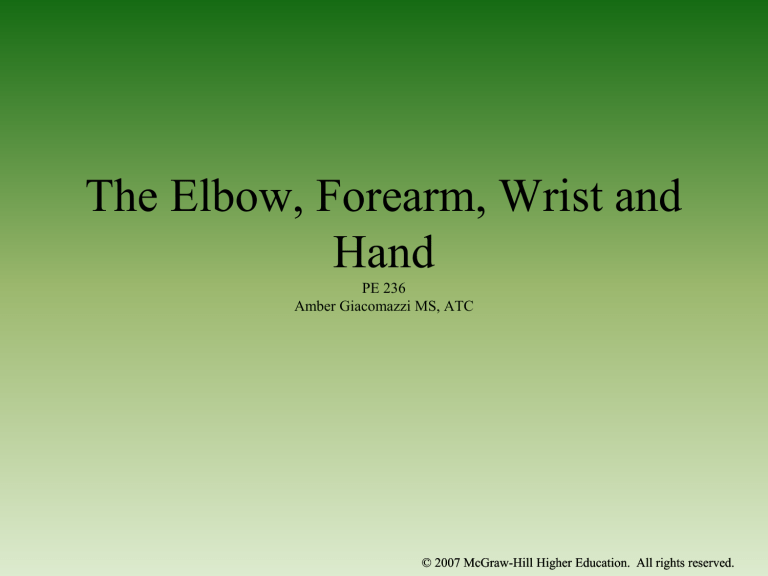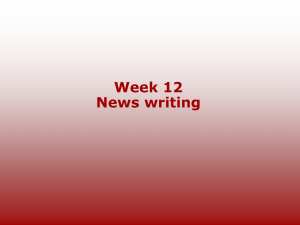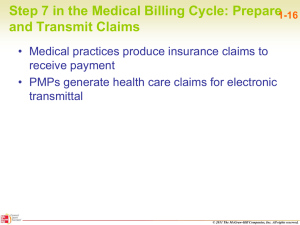
The Elbow, Forearm, Wrist and
Hand
PE 236
Amber Giacomazzi MS, ATC
© 2007 McGraw-Hill Higher Education. All rights reserved.
© 2007 McGraw-Hill Higher Education. All rights reserved.
© 2007 McGraw-Hill Higher Education. All rights reserved.
Prevention of Elbow, Forearm
and Wrist Injuries
• Vulnerable to a variety of acute and chronic
injuries
• Protective gear is always recommended to
reduce severity of injury
• Chronic injury reduction
–
–
–
–
Limit repetitions (baseball, tennis)
Utilize _____________________
Use equipment that is appropriate for skill level
Maintain appropriate levels of __________,
___________, and ___________for activity
© 2007 McGraw-Hill Higher Education. All rights reserved.
Recognition and Management of
Injuries to the Elbow
• Olecranon Bursitis
– Cause of Injury
• _____________________ makes it extremely
susceptible to injury (acute or chronic) --direct blow
– Signs & Symptoms
• Pain, swelling, and point tenderness
• Swelling will appear almost _____________
____________________________________
© 2007 McGraw-Hill Higher Education. All rights reserved.
© 2007 McGraw-Hill Higher Education. All rights reserved.
• Contusion
– Cause of Injury
• Vulnerable area due to lack of padding
• Result of direct blow or repetitive blows
– Signs & Symptoms
• Swelling (rapidly after irritation of bursa or synovial
membrane)
– Treatment
• Treat w/ RICE immediately for at least 24 hours
• If severe, refer for X-ray to determine presence of
fracture
© 2007 McGraw-Hill Higher Education. All rights reserved.
• Elbow Sprains
– Cause of Injury
• Elbow ________________or a ___________force (often seen in
the cocking phase of throwing
– Signs & Symptoms
• Pain along _________ aspect of elbow
• Inability to grasp objects
• Point tenderness over _____________
– Treatment
• Conservative treatment begins w/ RICE elbow fixed at
________in a sling for at least _____________
• Should be concerned with gradually regaining elbow full ROM
• Athlete should modify activity
– Gradual progression involving an increase in ________________
_____________________________________________
© 2007 McGraw-Hill Higher Education. All rights reserved.
Ligament Injuries
• Ulnar Collateral Ligament tear
– _______________
– _______________
• Signs and Symptoms
– Medial elbow pain
– Pop sensation
– Medial elbow swelling
• Treatment
– _________________________
• Elbow ligament reconstruction
© 2007 McGraw-Hill Higher Education. All rights reserved.
• Lateral Epicondylitis (______________)
– Cause of Injury
• Repetitive microtrauma to ____________________
_________________ of lateral epicondyle
– Signs & Symptoms
• Aching pain in region of lateral epicondyle after
activity
• Pain worsens and _________________
____________________develop
• Elbow has ________________; pain w/ ________
_____________________
© 2007 McGraw-Hill Higher Education. All rights reserved.
• Lateral Epicondylitis
– Treatment
• RICE, NSAID’s and analgesics
• ROM exercises and PRE, _________________,
hand grasping while in supination, _____________
____________________
• Mobilization and stretching in pain free ranges
• Use of a counter force or neoprene sleeve
• _________________ and __________________is
critically important
© 2007 McGraw-Hill Higher Education. All rights reserved.
• Medial Epicondylitis (_____________________)
– Cause of Injury
• Repeated ___________________ of wrist and ____________
torque of elbow
– Signs & Symptoms
• Pain produced w/ forceful flexion or extension
• Point tenderness and mild swelling
• ________________ of wrist seldom elicits pain, but
_________________________
– Treatment
• Sling, ______, ______________or heat through ultrasound
• Analgesic and NSAID's
• _____________________ below elbow to reduce elbow
stressing
• Severe cases may require splinting and complete rest for 7-10
days
© 2007 McGraw-Hill Higher Education. All rights reserved.
• Ulnar Nerve Injuries
– Cause of Injury
• Pronounced _________________may cause deep
friction problem
• Ulnar nerve _____________
– Signs & Symptoms
• Generally respond with _____________(numbness)
in ____ and____fingers
– Treatment
• Conservative management – avoid aggravating
condition
• Surgery may be necessary if _______________
________________________________
© 2007 McGraw-Hill Higher Education. All rights reserved.
• Dislocation of the Elbow
– Cause of Injury
• High incidence in sports caused by _______________
_______w/ elbow _________or severe ___________
_______________
– Signs & Symptoms
• Swelling, severe pain, disability
• May be displaced ________, _________, or _________
• Complications w/ ________and _________nerves and
_______________
– Treatment
• _____________and refer to physician for reduction
• Following reduction, elbow should remain splinted in
__________for ___________
© 2007 McGraw-Hill Higher Education. All rights reserved.
Elbow Dislocation
© 2007 McGraw-Hill Higher Education. All rights reserved.
© 2007 McGraw-Hill Higher Education. All rights reserved.
• Fractures of the Elbow
– Cause of Injury
• Fall on ___________ or from a _____________
• Fracture can occur in any one or more of the bones
• Fall on ____________ often fractures __________
above ___________or _____________condyles
– Signs & Symptoms
• May or may not result in ___________________
• ______________________________________
– Treatment
• Ice and sling for support – ___________________
© 2007 McGraw-Hill Higher Education. All rights reserved.
© 2007 McGraw-Hill Higher Education. All rights reserved.
Anatomy of the Forearm
© 2007 McGraw-Hill Higher Education. All rights reserved.
© 2007 McGraw-Hill Higher Education. All rights reserved.
© 2007 McGraw-Hill Higher Education. All rights reserved.
Recognition and Management of
Injuries to the Forearm
• Contusion
– Cause of Injury
• ____________receives majority of blows due to arm
blocks
• Can be ____________________
• Result of _______________________
– Signs & Symptoms
• Pain, swelling and hematoma
• If repeated blows occur, _____________and possibly
_____________ could form w/in a ______________
© 2007 McGraw-Hill Higher Education. All rights reserved.
• Contusion
– Treatment
• Proper care in acute stage involves ___________
__________ and followed up w/ additional
_____________
• _________is critical - full-length _________
________can be used to provide protective covering
© 2007 McGraw-Hill Higher Education. All rights reserved.
• Forearm Fractures
– Cause of Injury
• Common __________- due to falls and direct blows
• Fracturing ___________ singularly is ______than
simultaneous fractures to both
– Signs & Symptoms
• ___________ or ________followed by ________ to
___________, ________, and ____________
• Edema, ______________w/ possible __________
• _______________may experience extensive
damage to soft tissue structures
© 2007 McGraw-Hill Higher Education. All rights reserved.
– Treatment
• RICE, splint,
immobilize and
refer to physician
• Athlete is usually
incapacitated for
___________
© 2007 McGraw-Hill Higher Education. All rights reserved.
• Colles’ Fracture
– Cause of Injury
• Occurs in lower end of
radius
• MOI is fall on
outstretched hand,
forcing radius and ulna
into hyperextension
© 2007 McGraw-Hill Higher Education. All rights reserved.
© 2007 McGraw-Hill Higher Education. All rights reserved.
© 2007 McGraw-Hill Higher Education. All rights reserved.
– Signs & Symptoms
• Forward displacement of radius causing visible
deformity (__________________)
• When no deformity is present, injury may be passed
off as bad sprain
• Extensive bleeding and swelling
• Tendons may be torn/avulsed and there may be
median nerve damage
– Treatment
• Cold compress, splint wrist and refer to physician
• X-ray and immobilization
• ___________ complications a Colles’ fracture will
keep an athlete out for ____________
© 2007 McGraw-Hill Higher Education. All rights reserved.
Anatomy of the Wrist, Hand and
Fingers
© 2007 McGraw-Hill Higher Education. All rights reserved.
© 2007 McGraw-Hill Higher Education. All rights reserved.
© 2007 McGraw-Hill Higher Education. All rights reserved.
© 2007 McGraw-Hill Higher Education. All rights reserved.
Recognition and Management of
Injuries to the Wrist, Hand and
Fingers
• Wrist Sprains
– Cause of Injury
• Most common wrist injury
• Arises from any __________, _________movement
• Falling on ________________, ___________or
__________
– Signs & Symptoms
• Pain, swelling and difficulty w/ movement
© 2007 McGraw-Hill Higher Education. All rights reserved.
– Treatment
•
•
•
•
____________________ for _______ if severe
RICE, splint and analgesics
Have athlete begin strengthening soon after injury
Tape for support can benefit healing and prevent
further injury
© 2007 McGraw-Hill Higher Education. All rights reserved.
• Scaphoid / Navicular Fracture
– Cause of Injury
• Caused by force on outstretched hand, compressing
scaphoid between _______ and _________of
_________________
– Signs & Symptoms
• Swelling, severe pain in _____________________
– Treatment
• Must be splinted and referred for X-ray prior to
casting
– _____________________________________
• ____________lasts __________and is followed by
______________ and _______________
• Wrist requires protection against impact loading for
3 additional months
• Often fails to heal due to poor _________________
© 2007 McGraw-Hill Higher Education. All rights reserved.
© 2007 McGraw-Hill Higher Education. All rights reserved.
• Metacarpal Fracture
– Cause of Injury
• _____________ force or ______________force
• Fractures of the ________________are associated
w/ boxing or martial arts (______________)
– Signs & Symptoms
• Pain and swelling; possible _______ or
_________deformity
• Palpable defect is possible
– Treatment
• RICE, refer to physician for ________ and
_____________
• Deformity is reduced, followed by splinting _______________
© 2007 McGraw-Hill Higher Education. All rights reserved.
© 2007 McGraw-Hill Higher Education. All rights reserved.
Recognition and Management of
Finger Injuries
• Mallet Finger
– Cause of Injury
• Caused by a blow that contacts tip of finger
________ ________________ from ___________
– Signs & Symptoms
• Pain at _____; X-ray shows avulsed bone on ______
_______________________
• Unable to ________ distal end of finger (carrying at
___________angle)
• Point tenderness at sight of injury
– Treatment
• RICE and splinting (in ___________) for 6-8 weeks
© 2007 McGraw-Hill Higher Education. All rights reserved.
• Boutonniere Deformity
– Cause of Injury
• Rupture of ________tendon ________to the
middle phalanx
Forces _____ joint into extension and _____ into
flexion
– Signs & Symptoms
• Severe pain, obvious deformity and inability to
_______DIP joint
• Swelling, point tenderness
– Treatment
• Cold application, followed by _________of ____
• Splinting must be continued for ________
• Athlete is encouraged to ____________________
© 2007 McGraw-Hill Higher Education. All rights reserved.
• Gamekeeper’s Thumb
– Cause of Injury
• Sprain of ____ of ____ joint of the thumb
• Mechanism is _____________ of ______________
occasionally combined w/ ______________
– Signs & Symptoms
• Pain over UCL in addition to ____ and painful _______
• Tenderness and swelling over __________ aspect of thumb
– Treatment
•
•
•
•
Immediate follow-up must occur
If ___________ exists, athlete should be referred to _________
If stable, X-ray should be performed to rule out ___________
_____________should be applied for protection for
________or until pain free
© 2007 McGraw-Hill Higher Education. All rights reserved.
© 2007 McGraw-Hill Higher Education. All rights reserved.
• Dislocation of Phalanges
– Cause of Injury
• Blow to the tip of the finger (____________
__________________________ )
– Forces 1st or 2nd joint ______________
• Results in tearing of ___________________and
____________________
• Possible rupture of __________ or
____________tendon(s) and/or
_________________may also occur
– Treatment
• ____________ should be performed by physician
• X-ray to rule out fractures
• Splint for ________ in _________of __________
– Inadequate immobilization may lead to _________
___________________________________
• Buddy-tape for support upon return
© 2007 McGraw-Hill Higher Education. All rights reserved.
– Treatment
• Special consideration must be given for ________
dislocations and ________ dislocations
• MCP joint of thumb dislocation occurs with thumb
forced into _________________
• Any MCP dislocation will require ________________
by a physician
© 2007 McGraw-Hill Higher Education. All rights reserved.









